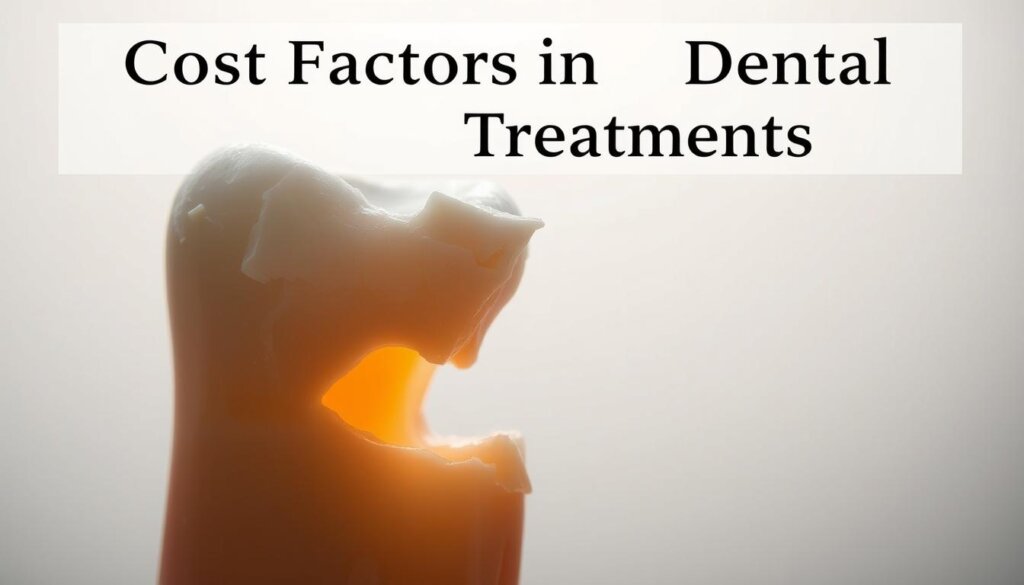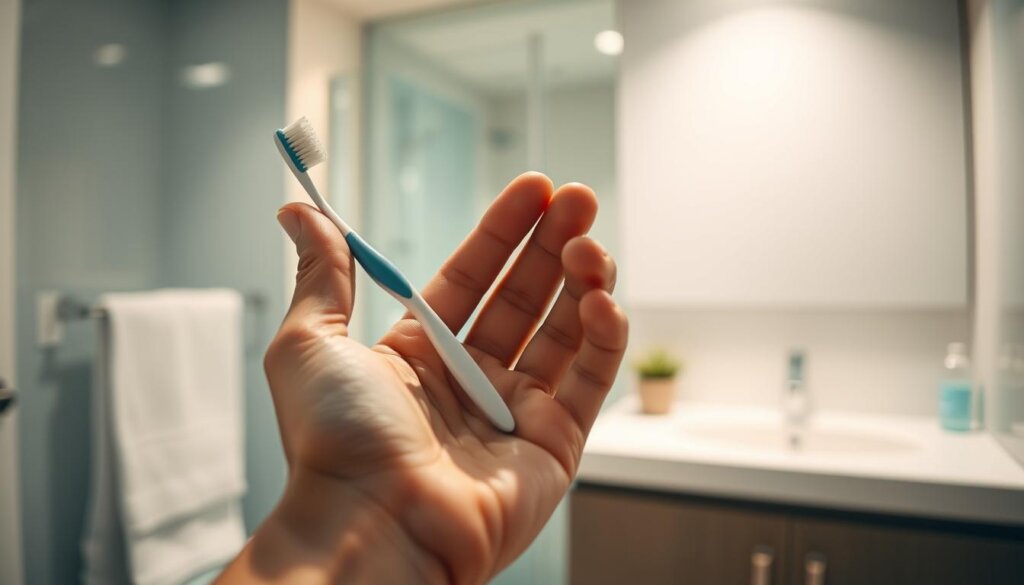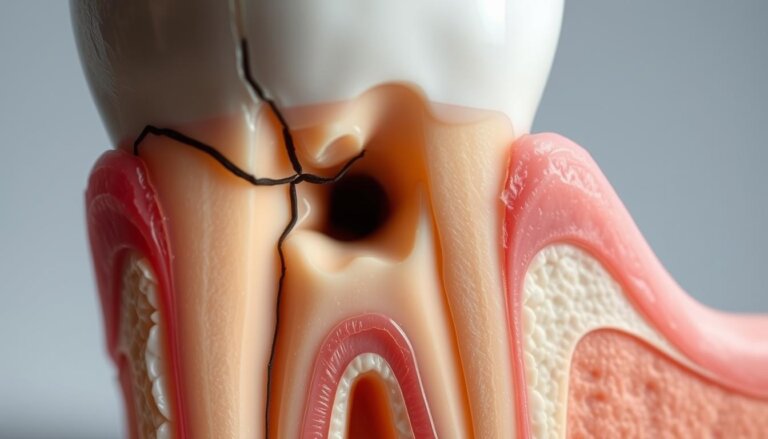Fixing a Broken Tooth: Should You Wait for Pain?
Did you know that about one in five dental emergencies in the United States are due to cracked or broken teeth? This shows how common sudden tooth damage is. It also highlights why getting help right away is so important.
Many wonder, can I wait until it hurts to fix a broken tooth? Teeth can’t heal themselves, so waiting can let bacteria get to the pulp. This can cause inflammation. Pain usually shows up after serious damage, which can lead to nerve damage or infection.
Key Takeaways
- Seeking quick care often prevents infection.
- Pain is a late sign that indicates deeper harm.
- Teeth lack the ability to self-repair damaged enamel.
- Early intervention saves time and costs.
- Dentists can identify breakage severity before it worsens.
- Prompt action helps protect long-term oral health.
Understanding Broken Teeth
Teeth can break from sudden impacts, grinding, or biting hard objects. This can happen without warning or quietly until pain becomes noticeable. Many watch for broken tooth pain as a key sign, but there are other subtle signs too.
Common Causes of Broken Teeth
Accidents during sports and clenching can strain teeth. Biting hard candy or kernels can cause micro-cracks. Aging also makes teeth more fragile, raising the risk of breakage.
Types of Tooth Breakage
Minor chips only affect the outer layer. A fracture can go deeper into dentin. Hairline cracks might be hard to see without a check-up. Severe breaks can expose the pulp, making the tooth vulnerable to infection.
Signs of a Broken Tooth
Jagged edges, swelling, or tender spots when chewing show a problem. Some feel sudden sensitivity to hot or cold foods. Broken tooth pain can get worse if the fracture gets bigger or if bacteria get in, making it important to see a dentist quickly.
The Importance of Dental Care
Teeth need constant care to stay healthy. Regular brushing and dental visits prevent big problems. Catching small cracks early can avoid a dental emergency.
Being careful helps keep your teeth working well. It also saves you from expensive dental bills.
Preventive vs. Reactive Care
Preventive care stops serious dental work. It includes brushing, cleanings, and mouthguards for sports. If you wait, you might need crowns or root canals.
Seeing a dentist early can make you feel better faster.
Long-term Effects of Neglecting Treatment
Ignoring small chips can lead to infections or bigger cracks. These can cause tooth loss and long healing times. Waiting too long means more pain and expensive fixes.
| Method | Primary Benefit |
|---|---|
| Routine Exams | Early detection of fractures |
| Preventive Cleaning | Reduces bacterial risks |
| Immediate Repairs | Stops further tissue damage |
What Happens If You Wait for Pain?
Tooth damage often seems harmless at first. Tiny fractures progress beneath the surface, weakening the enamel. This opens the door to bigger complications. Prolonging care can jeopardize daily comfort and overall well-being. Delaying broken tooth treatment heightens the likelihood of hidden lesions.
Delayed Treatment Risks
Some individuals hope mild discomfort will resolve on its own. This approach overlooks unpredictable complications:
- Nerve exposure leading to sharper sensitivity
- Underlying infections resulting in acute discomfort
- Weakening structural integrity that accelerates damage
Experts at Mayo Clinic confirm that delaying broken tooth treatment can pave the way for unwanted procedures and extended healing times. Dental deterioration may even affect adjacent teeth.
Signs That Indicate Immediate Attention
Dental specialists warn that throbbing gums, ongoing swelling, or sudden pressure sensitivity signify urgent evaluation. Visible chips that keep catching the tongue point to worsening fractures. Prompt diagnostic imaging helps uncover underlying threats.
A professional exam can detect early damage that does not hurt yet. Swift corrections preserve tooth function and ward off future surgeries.
| Potential Issue | Outcome |
|---|---|
| Inflamed Pulp | Severe Sensitivity |
| Lingering Bacteria | Possible Abscess Formation |
| Fractured Edges | Increased Risk of Infection |
Options for Treating Broken Teeth
Many people seek lasting solutions after a tooth breaks. Steps like dental bonding, crowns, and root canals protect the tooth. These methods offer more than just temporary relief.
Dental Bonding
Dental bonding uses a resin that looks like enamel. It fixes small chips and makes the tooth look new again. This method is quick and saves much of the original tooth.
Crowns and Caps
For bigger breaks, a crown or cap is needed. It covers the tooth, making it strong again. Crowns can be made of porcelain or metal, depending on the tooth’s needs.
Root Canals
Deep cracks can hurt the tooth’s inside. A root canal removes the infected pulp. It saves the tooth and stops infection from spreading.
| Option | Key Feature | Consideration |
|---|---|---|
| Dental Bonding | Quick resin application | Ideal for smaller chips |
| Crowns and Caps | Full coverage solution | Extensive prep needed |
| Root Canal | Removes infected pulp | Preserves natural tooth |
How Pain Signals Dental Issues
Teeth and gums often give us important clues when something is wrong. A quick pain might go away fast, but ongoing pain could mean a bigger problem. Feeling pain when eating or drinking cold things might be a sign.
At times, a throbbing pain could mean an infection or exposed nerves. This can get worse if not treated quickly.
When to Seek Emergency Care
Some situations need you to call a dentist right away. If pain keeps you awake, your jaw swells, or your gums bleed, you need urgent care. Broken teeth can lead to infections or abscesses if not treated.
Seeing a dentist quickly can find the cause and help fix it.
Pain Levels and Their Meanings
Mild pain might mean your tooth is starting to damage. More severe pain could mean a hidden fracture. A sharp pain might mean your nerves are exposed, needing quick help.
Knowing these pain levels helps avoid making things worse.
| Pain Type | Possible Cause | Recommended Action |
|---|---|---|
| Dull Ache | Early Tooth Damage | Schedule Dental Checkup |
| Sharp Throb | Enamel or Nerve Exposure | Seek Prompt Evaluation |
| Extreme Pain | Deep Infection | Immediate Professional Treatment |
Cost Factors in Dental Treatments
Many people worry about the cost of dental care. Waiting for pain to start treatment can be costly. Early action, like sealing a small crack, can save money in the long run. Is it worth waiting for more expensive fixes?
Looking at costs, simple fixes are cheaper than complex ones. Bonding or fillings are easier than root canals or crowns. It’s smart to look at treatment options for a broken tooth early to avoid more costly procedures.
Comparing Immediate vs. Delayed Treatment Costs
Waiting too long can cause infections or bone loss. Minor fixes are cheaper than surgery or implants. Quick action saves money and keeps your teeth healthy.
Insurance Coverage Considerations
Plans from Delta Dental or Cigna cover preventive care well. People with good plans pay less when they act fast. Dentists help pick the right treatment without surprise costs.
| Procedure | Approximate Cost |
|---|---|
| Dental Bonding | $100 – $400 |
| Crown Placement | $800 – $1,500 |
| Root Canal Therapy | $700 – $1,200 |
| Simple Extraction | $100 – $300 |
Pain Management Strategies
Many people look for quick fixes when they’re in pain. Short-term solutions can help until they can get proper care. This guide shows how to manage pain while keeping health in mind.
Over-the-Counter Medications
Nonsteroidal anti-inflammatory drugs are often the first choice. They help reduce swelling and pain. Ibuprofen or naproxen are good options for quick relief without a doctor’s prescription.
| Medication | Key Benefit | Consideration |
|---|---|---|
| Ibuprofen | Targets swelling | Monitor intake frequency |
| Naproxen | Long-lasting effect | Check dosage intervals |
Home Remedies for Relief
Simple home remedies can offer comfort. A cold compress near the jaw can ease pain. Clove oil can also numb sensitive areas. These methods help manage pain but don’t replace professional advice.
Temporary Solutions Before Treatment
Many people take simple steps to protect their teeth before seeing a dentist. Covering any exposed or jagged fragment helps shield gums and cheeks. This shows proactive dental care by reducing irritation and infection risk.
Scientific sources stress the importance of early action. Having a plan before professional treatment helps keep the tooth intact. How does this help patients stay calm and confident?
Dental Wax Use
Dental-grade wax, found at local pharmacies, acts as a shield over rough edges. Soften a small piece between clean fingers to apply it. If wax is not available, sugar-free gum can also help reduce discomfort.
- Gently dry the area before applying wax
- Replace it whenever it becomes loose
Avoiding Certain Foods
Staying away from crunchy or chewy foods helps avoid further damage. Nuts or candy can make minor fractures worse. Opting for liquid-based meals and softer items aids in healing and supports proactive dental care.
| Temporary Measure | Key Benefit |
|---|---|
| Dental Wax | Buffers sharp edges |
| Sugar-Free Gum | Temporarily seals minor cracks |
| Soft Food Choices | Limits stress on damaged tooth |
Finding the Right Dentist
Finding a skilled dentist is key when you have a broken tooth. They should know a lot about fixing teeth and handling emergencies. This helps keep your teeth healthy for a long time and avoids bigger problems.
Getting a good check-up is important. It includes tests and plans made just for you. Catching small tooth problems early means you can get help fast. This keeps your life on track and helps your teeth stay healthy.
Importance of Experience and Specialization
A dentist’s education shows they are up-to-date with the latest in dentistry. They use the newest methods to fix your teeth without losing too much of it. They pay close attention to every detail, making you feel more comfortable with your treatment choices.
Patient Reviews and Recommendations
Looking at online reviews and talking to friends can help you find a good dentist. Reviews talk about how well the dentist communicates, how they handle pain, and the office atmosphere. This feedback helps you know what to expect and builds trust in your dentist.
Understanding the Treatment Process
Many patients find reassurance by knowing the steps to fix a damaged tooth. A detailed plan starts with looking at medical history. Then, specific tests are done to find any problems or infection risks.
Initial Consultation Steps
Doctors first talk about your health and any pain you’re feeling. They use X-rays to see hidden damage. This helps decide the best way to fix your tooth.
What to Expect During Treatment
Next, you’ll discuss the best treatment option. This could be a filling, crown, or more. The main goals are to stop infection, fix the tooth, and reduce pain. You’ll know how long it will take and if you need to come back for more visits.
| Step | Purpose |
|---|---|
| Medical Review | Collect patient history to spot possible issues |
| Imaging & Diagnostics | Show the tooth’s condition and hidden decay |
| Treatment Discussion | Explain repair options and expected time |
| Restoration | Fix the tooth’s function and look while lowering infection risk |
Aftercare Following Treatment
Proper healing is key to long-term dental health. Simple steps can help prevent irritation or discomfort. Daily oral hygiene is important for tissue recovery and strengthening teeth.
Recovery Tips and Guidelines
Rinsing with warm saltwater keeps the area clean. This helps reduce inflammation. Use soft-bristled brushes and mild toothpaste to avoid friction on treated surfaces.
Regular check-ups are vital to catch any early problems. Mild pain medications might be helpful, but always ask a dentist first. Keeping track of your healing progress can also give you peace of mind.
Foods to Avoid After Treatment
Experts advise avoiding foods that can harm restorations. Here are some examples:
- Hard candies or popcorn kernels
- Chewing gum or sticky chocolates
- Excessively hot or cold drinks
Eating balanced meals that don’t stress your teeth helps recovery. This supports long-lasting results.
The Importance of Regular Check-Ups
Many people wait until they’re in a lot of pain to see the dentist. This means they often miss small problems that could be fixed early. Regular dental visits are key to catching these issues before they get worse.
Preventing Future Dental Issues
Going to the dentist often helps find hidden problems like cracks or early decay. If caught early, fixing these issues is easier and saves more of your natural tooth. Regular visits help avoid bigger problems and keep your teeth healthy for longer.
Monitoring Oral Health
Regular dental visits let experts watch for changes in your mouth. Are new areas of tooth wear showing up? Is your old dental work holding up? These checks help dentists give you the best advice for a healthy smile. Catching problems early means fewer surprises and better results.
Myths About Broken Teeth
Many think a cracked or chipped tooth is okay until it hurts. But ignoring it can cause more harm. Teeth can’t fix themselves, and untreated cracks can lead to infections.
Teeth face constant pressure from food, drinks, and temperature changes. A small crack can grow, letting bacteria in and risking your oral health.
Common Misconceptions
Some believe hairline fractures will fix themselves. But teeth can’t replace lost material. Ignoring damage can lead to bigger problems and more complex treatments.
Facts vs. Fiction in Dental Care
Another myth is that enamel is forever strong. But acidic foods and grinding can weaken it. A dentist can spot these risks early. Regular dental visits can prevent small cracks from becoming big problems.
| Myth | Fact |
|---|---|
| Cracks disappear | They expand or worsen without care |
| No pain means no problem | Serious damage can occur before pain |
| Surface chips are minor | They may invite decay and infection |
Encouraging Kids to Care for Their Teeth
Teaching kids to care for their teeth early is key. It helps them develop good habits for a lifetime. Simple reminders and fun lessons make them understand why brushing and flossing are important.
Teaching Proper Hygiene
Start with small steps for good oral care. Brushing with fluoride toothpaste twice a day gets rid of plaque. Flossing reaches hidden spots. Fun activities like brushing together and using colorful charts make it exciting.
- Demonstrate correct brushing angles
- Promote regular rinsing with mouthwash
- Suggest mouthguards for sports events
How to Handle Dental Emergencies
Accidents can chip or fracture teeth. Stay calm, rinse with warm water, and call a dentist. Quick action can prevent more damage. Teach kids to speak up if they’re in pain.
Emotional and Social Impacts of Broken Teeth
A broken tooth can make you feel anxious and self-conscious. You might worry that people will judge your smile. This fear can make you shy away from social events or work meetings.
The Effect on Self-Esteem
When you’re worried about how you look, your confidence can drop. Gaps or sharp edges can make you feel self-conscious. This can make it hard to speak, laugh, or share ideas at work.
But, positive feedback from friends and family can help boost your self-image. It reminds you that you’re more than your teeth.
How to Cope with Dental Anxiety
Many people get nervous about dental visits. Talking openly with your dentist can help build trust. It can also clear up any worries you have.
Some people find comfort in listening to calming music or practicing deep breathing during their visit. Others might choose to take a mild sedative. Here are a few tips to help you cope:
- Make sure to visit your dentist regularly to catch problems early
- Talk to your dentist about relaxation options they offer
- Learn some stress management techniques to help you relax
Conclusion: Don’t Wait for Pain
Dentists say you should see a dentist for broken teeth before you feel pain. Even a small chip can turn into a big problem. Getting help early keeps your teeth safe and prevents infections.
Studies by the American Dental Association show waiting too long can lead to more serious and expensive treatments. Acting fast keeps your mouth working well and avoids bigger issues.
The Importance of Prompt Action
Fixing small problems early can be as simple as bonding or a small filling. This stops the damage from getting worse. It also keeps your mouth healthy and stops bacteria from growing.
Your Smile Deserves Care
Fixing problems early saves time and money and boosts your confidence. A healthy smile makes you feel good and helps you connect with others. Taking care of your teeth means they will stay strong for a long time.





